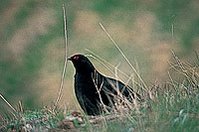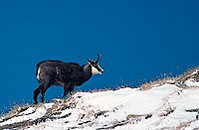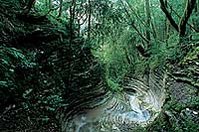Biological diversity in the Caucasus
Contents
- 1 Overview Map of the Caucasus. (Source: CI (Biological diversity in the Caucasus) /CABS)
- 2 Unique and Threatened Biodiversity
- 3 Human Impacts
- 4 Conservation Action and Protected Areas
- 5 NotesThis article is based on contributions from Russell A. Mittermeier, Olivier Langrand, Porter P. Lowry II, George Schatz, Justin Gerlach, Steven Goodman, Marc Steininger, Frank Hawkins, Noro Raminosoa, Olga Ramilijaona, Luciano Andriamaro, Harison Randrianasolo, Harison Rabarison, and Zo Lalaina Rakotobe.For a complete list of all contributors to the Biodiversity Hotspot program, see Biodiversity Hotspot Site Credits (Biological diversity in the Caucasus) .
- 6 Further Reading
Overview Map of the Caucasus. (Source: CI (Biological diversity in the Caucasus) /CABS)
The Caucasus hotspot spans 532,658 km2 in the nations of Georgia, Armenia, and Azerbaijan, the North Caucasian portion of the Russian Federation (including the Dagestan, Chechnya, Ingushetia, Northern Ossetia, Kabardino-Balkaria, Karachai-Cherkesia, and Adigea Autonomous Republics), the northeastern part of Turkey, and a part of northwestern Iran. In the southern reaches, this hotspot integrades with the Irano-Anatolian Hotspot.
The topography of the Caucasus comprises the Greater Caucasus Range (with the highest peak being Mt. Elburz at 5,642 meters), the Lesser Caucasus Mountain Chain (to 4,000 meters), the South Caucasian Uplands (covering parts of the Asia Minor, Armenian, and Iranian uplands), and the Transcaucasian Depression, between the Greater Caucasus Range and the Lesser Caucasus Mountain Chain. More than 2,000 glaciers cover 1,450 km2 in the Greater Caucasus Range. The northern third of the hotspot is the broad North Caucasus Plain, the eastern part of which is below sea level. Climate throughout the region is variable, with annual rainfall ranging from as little as 150 millimeters in the eastern part of the hotspot on the Caspian Coast to more than 4,000 millimeters in the coastal mountains along the Black Sea.
The vegetation of the Caucasus is also quite diverse. In the northern part of the hotspot, grassland steppes in the west transition to semidesert ecosystems, and then to desert in the east. In the central Transcaucasian Depression, swamp forests, steppes, and arid woodlands are replaced by semideserts and deserts along the Caspian Sea. Scattered throughout the hotspot are broadleaf forests, montane coniferous forests, and shrublands. There are two refugia of Tertiary flora in the region: the Colchis in the catchment basin of the Black Sea, and the Hyrcanian in the extreme southeastern end of the Caucasus on the Caspian Sea coast.
Unique and Threatened Biodiversity
Plants
The Caucasus hotspot is home to about 6,400 plant species, more than 1,600 of which (25 percent) are restricted to the region. There are 17 endemic genera of plants here, nine of which are associated with high mountain ecosystems. Endemism is particularly high in rocky-scree environments in this range; 80 percent of the plants growing on the Colchic limestone scree are found nowhere else in the world.
The flora of the Caucasus region includes many ancient species, and many forms are still dominant or co-dominant in the hotspot's plant communities. Notable relict species include the endemic rhododendrons (Rhododendron caucasicum, R. ungernii, R. smirnowii) and Persian ironwood (Parrotia persica).
The region also harbors a remarkable concentration of economically important plants, particularly wild crop relatives such as wheat, rye and barley, as well as nuts and fruits like walnuts, apricots and apples.
Vertebrates
Birds
There are more approximately 380 bird species in the hotspot, though only one is endemic according to the definition of the region adopted here, namely the Caucasian snowcock (Tetraogallus caucasicus). The hotspot hosts several globally threatened waterbird species, including the marbled duck (Marmaronetta angustirostris, VU), lesser white-fronted goose (Anser erythropus, VU) and the white-headed duck (Oxyura leucocephala, EN).
The hotspot contains significant numbers of breeding raptor populations and is an important corridor for migratory birds. Each summer and autumn, millions of birds pass through along two major migration routes on the east coast of the Black Sea and the west coast of the Caspian Sea.
Mammals
There are about 130 mammal species in the Caucasus hotspot, nearly twenty of which are endemic and several of which are threatened. Like other young [[mountain] ranges], the Caucasus region has both newly evolved species as well as ancient relict species. Here, ancient and primitive mammals are represented by the unusual long-clawed mole-vole (Prometheomys schaposchnikowi), and representatives of the genera Mesocricetus, Sicista, and Apodemus.
Several large threatened mammal species are found in this hotspot, including the Caucasian tur (Capra caucasica, EN), a member of the goat family. The Caspian monk seal (Phoca caspica, VU) also breeds along the shores of the Caspian Sea. Threatened small mammal species occurring in the Caucasus include the Mediterranean horseshoe bat (Rhinolophus euryale, VU), Mehely's horseshoe bat (R. mehelyi, VU), and the Armenian birch mouse (Sicista armenica, CR), which is known only from the type locality.
Reptiles
Reptiles are represented by nearly 90 species, about 20 of which are endemic. The hotspot is a center of endemism for the lizard genera Lacerta and Darevskia; nearly half of the world’s 60 species are present in the Caucasus, and half of those are endemic. Interestingly, several of these species (Darevskia dahli and D. armenica) are parthenogenic, meaning that there are no males, and females reproduce entirely on their own.
Other notable reptiles include the endemic Caucasian viper (Vipera kaznokovi, EN). The venom of this species is useful for stopping excessive bleeding in surgery patients, and the snake is exploited for the black market trade.
Amphibians
Amphibian diversity is relatively low, with 17 species, only a few of which are endemic. The colorful Caucasian salamander (Mertensiella caucasica, VU) is the region's best-known amphibian species, endemic to the West Caucasus of Georgia and Turkey. One of the most remarkable amphibians in the hotspot is the Gorgan salamander (Batrachuperus gorganensis, CR), which numbers only about 100 breeding adults and is restricted to Shir-Abad Cave and the stream flowing from it in northwestern Iran.
Freshwater Fishes
The region has more than 125 fish species, though only about a dozen are endemic. Among the most interesting species are three lampreys, Caspiomyzon wagneri, Eudontomyzon mariae and Lampetra lanceolata. Lampreys are ancient jawless, scaleless fish that date back 280 million years, and have the highest number of chromosomes of all vertebrates (164-174). Another ancient group of fish in the hotspot are seven species of sturgeon, including the famous Beluga sturgeon (Huso huso, EN), the largest freshwater fish and the source of high-value caviar. Populations of all sturgeon species have been reduced through overharvesting, primarily for caviar, while other threats include water pollution and damming, which restricts anadromous migrations.
Invertebrates
Invertebrates, especially insects, are quite diverse, and, in the uplands of the Caucasus, one can observe many examples of the varied insect life, including an endemic butterfly (Parnassius nordmanni) and the Rosalia longicorn beetle (Rosalia alpine, VU).
Human Impacts
The Caucasus region has been inhabited and affected by human communities for tens of thousands of years, with on average nearly half of the land in the region already transformed by human activities. Nevertheless, several pristine areas remain in the hotspot, mostly in remote high-altitude areas and inaccessible gorges. About 27 percent of the area, totaling 145,000 km2, remains as natural habitat; however, only about 12 percent of the original vegetation is considered pristine. Most of the hotspot's intact ecosystems are concentrated in inaccessible high mountain sites, while the plains and the foothills have suffered the most habitat loss.
The conservation situation in the Caucasus region has deteriorated because of the social and economic crises that have plagued the region since 1992. A lack of fuel and alternate energy sources has doubled and tripled firewood consumption in some areas, increasing illegal timber cutting. Overgrazing by sheep has eroded the natural vegetation in more than 30 percent of subalpine and alpine summer ranges and about 50 percent in the winter ranges of the steppe and semidesert areas.
The poaching of wild animals has increased significantly since the 1990s. The animals at the highest risk from poaching are the leopard (Panthera pardus), brown bear (Ursus arctos), wolf (Canis lupus), Bezoar goat (Capra aegagrus, VU) and the tur (Capra caucasica, EN). The last species, which still numbered in the hundreds of thousands in the middle of this century, has now been drastically reduced because of the combination of poaching and greatly increased development of pastureland. Today, only about 4,000 of the eastern subspecies and 6,000-10,000 of the western subspecies remain.
Conservation Action and Protected Areas
There is a long tradition of nature conservation in the Caucasus. The first state nature reserve, the Lagodekhi Gorge in Georgia, was created in 1912. Since then, establishment of strict nature reserves became a key part of conservation activities in the region. Today, protected areas cover roughly 44,000 km2, or eight percent of the region's total land area; 39,000 km2 of this (7.3 percent) is in protected areas in IUCN categories I to IV. Several thousand square kilometers are also protected in hunting reserves, which offer some degree of protection and resource management.
Nonetheless, the integrity of many protected areas is under threat from increased poaching, illegal logging, and grazing. The reduced capacity and resources of government agencies make conservation priorities difficult to enforce. More remaining habitat in the Caucasus hotspot needs to be formally protected to ensure the long-term survival of the region's biodiversity. Much of the remaining land in the region is government owned, meaning that it could be protected relatively easily and quickly. As market economies gain strength in the region, land ownership will pass to private owners, and the opportunity to easily create new reserves will be lost.
Plans are being made for a trans-boundary protected area on the border between Georgia, Azerbaijan, and Russia. Trans-boundary projects are important conservation priorities in the region for connecting populations of wide-ranging species in the region’s fragmented habitats, as well as for protecting threatened and endemic species of fish in the region's rivers and lakes.
The nation of Georgia has taken several important steps toward improved biodiversity conservation in recent years and plans to expand the 760-km2 Borjomi-Kharagauli National Park. The Georgia Parliament adopted a new protected areas system law based on IUCN recommendations, and the president pledged to protect 15 percent of the country's total forest area as Georgia's "Gift to the Earth." With support from the World Bank/GEF, three additional national parks have been created.
Elsewhere, Azerbaijan’s Ministry of Ecology and Natural Resources has been actively developing a protected areas system with the creation of new national parks and the expansion of existing protected areas. In 2004, two new national parks were gazzeted in the Turkish Caucasus covering a total area of 1,050 km2. Russia has increased its investment in nature conservation in the northern Caucasus four-fold over the past few years, including the creation of new protected areas.
In addition, WWF has been working in the Caucasus since 1990 on nature conservation and environmental education projects. Conservation priority areas for WWF in the Caucasus include the East Caucasian floodplains, the southern Colchic montane forests, and the woodlands of southern Armenia. The Georgian Center for the Conservation of Wildlife is an important national organization working on biodiversity conservation.
In 2003, the Critical Ecosystem Partnership Fund began a five-year $8.5 million investment in the Caucasus region to focus on conserving the hotspot’s globally threatened and restricted-range species. CEPF is targeting its investments on a set of thematic and geographic priorities, the latter of which include a subset of Key Biodiversity Areas (among the 205 KBAs defined for the region by WWF-Caucasus in collaboration with the BirdLife partnership) and five different conservation corridors: Greater Caucasus, Caspian, West Lesser Caucasus, East Lesser Caucasus, and Hyrcan. This is one example of conservation plans that have been developed for the region based on wide stakeholder involvement, but these processes are still in crucial need of further financial and technical support.
NotesThis article is based on contributions from Russell A. Mittermeier, Olivier Langrand, Porter P. Lowry II, George Schatz, Justin Gerlach, Steven Goodman, Marc Steininger, Frank Hawkins, Noro Raminosoa, Olga Ramilijaona, Luciano Andriamaro, Harison Randrianasolo, Harison Rabarison, and Zo Lalaina Rakotobe.For a complete list of all contributors to the Biodiversity Hotspot program, see Biodiversity Hotspot Site Credits (Biological diversity in the Caucasus) .
Further Reading
- Abuladze, A. V. 1995. Status and Conservation Problems of Raptors in the Caucasus. Abstracts of International Conference on Holarctic Birds of Prey. Badajoz, Spain, April 17-22, 1995.
- Bannicov, A.G. & Darevsky, I.C. 1997. Definition of Amphibian and Reptiles of the USSR Fauna. Prosveschenie, Moscow.
- Berg, L.S. 1948. The Freshwater Fishes of the USSR and Adjacent Countries. Part 1 Nauka, Moscow & Leningrad, Russia. English translation by the National Science Foundation, Washington DC, 1962.
- Birstein, V. J. 1993. Sturgeons and paddlefishes: Threatened fishes in need of conservation. Conservation Biology, 7:773-787.
- Bischoff W, 2001. Übersicht der Arten und Unterarten der Familie Lacertidae. 6. Nachtrag. Die Eidechse, 12(1):17-25.
- Bukhnikashvili, A. & Kandaurov, A. 1998. Threatened and insufficiently studied species (Insectivora, Rodentia). ‘Bersuma’, Tbilisi: 91.
- Darevsky, I. S., 1967. Skal’nye jashchericy Kavkaza (Rock Lizards of the Caucasus). Leningrad, Nauka (in Russian).
- Dolukhanov, A.G. 1966. Vegetation cover. In I.P. Gerasimov. The Caucasus. Nauka, Moscow.
- Frimodt, C. 1995. Multilingual Illustrated Guide to the World's Commercial Coldwater Fish. Fishing News Books. Oxford, England: Osney Mead. ISBN: 0852382138
- Gagnidze, R., Gviniashuili, T., Shetekauri, S., & Margalitadze, N. 2002. Endemic genera of the caucasus flora. Feddes Repertorium, 113(7-8):616-630.
- Georgian Biodiversity Country Study Report. 1996. (Manuscr.). Georgian Biodiversity Study Program. Tbilisi: UNEP, Georgian Ministry of Environment and Nature Resources Protection, NACRES.
- Gromov, I. M. & Baranova, G.I. 1981. The Catalogue of Mammals of USSR. Nauka, Leningrad.
- Hardisty, M.W., 1986. A general introduction to lampreys. In J. Holcík. (Ed.), The Freshwater fishes of Europe. Vol. 1, Part 1. pp. 19-84. Petromyzontiformes.
- Heptner, W.G., Sludsky, A.A., Komarov, A. & Komorov, N. 1992. Mammals of the Soviet Union. Carnivora, Part 2: Predators (Hyenas and Cats). Leiden, The Netherlands & Kinderhook, New York, Brill Academic Publishers. ISBN: 9004088768
- Ivanov, A. I. 1976. The Catalogue of Birds of the USSR. Nauka, Leningrad.
- Lebedev, U.D. & Shpanowskaya, U.D. 1969. Fishes of the USSR. Misl, Moscow.
- Murphy, R.W., Darevsky, I.S., MacCulloch, R.D., Fu, J. & Kupriyanova, L.A., 1996. Evolution of the bisexual species of Caucasian rock lizards: A phylogenetic evaluation of allozyme data. Russian J. Herpetol., 3:18-31.
- Murphy, R.W., Fu, J., MacCulloch, R.D., Darevsky, I.S. & Kupriyanova, L.A., 2000. A Fine line between sex and unisexuality: The phylogenetic constraints on parthenogenesis in lacertid lizards. Zool. J. Linn. Soc., 130:527-549.
- Sokhadze, E.V. 1982. Limestone and Vegetation. Metsniereba, Tbilisi.
- Tarkhnishvili, D.N. & Gokhelashvili, R.K. 1999. The amphibians of the Caucasus. Advances in Amphibian Research in the Former Soviet Union, 5:1-200.
- Tarkhnishvili, D.N., Thorpe, R.S. & Arntzen, J.W., 2000. Pre-pleistocene refugia and differentiation between populations of the Caucasian salamander (Mertensiella caucasica). Molecular Phylogenetics and Evolution, 14:414-422.
- Weinberg, P.I. 1997. Information about Present Situation of the Mountain Goats in the CIS Territory. Abstracts from the International Conference - Rare Species of the Mammals in Russia and Adjoining Territories. April 9-11, 1997. Moscow.
- WWF International. 1997. 100 European Forests We Should Protect Now (Map). WCMC.
- WWF Technical Reports of Project. 2002-2004. Leopard Conservation in the Caucasus Ecoregion. Prepared by Victor Lukarevski. Archive of WWF Caucasus Programme Office.
- Zazanashvili, N., Sanadiradze, G. & Bukhnikashvili, A. 1999. Caucasus. In R.A. Mittermeier, N. Myers & C. Goettsch Mittermeier. (Eds.), Hotspots – Earth’s Biologically Richest and Most Endangered Terrestrial Ecoregions. Mexico City: CEMEX and Conservation International. ISBN: 9686397582
| Disclaimer: This article is taken wholly from, or contains information that was originally published by, the Conservation International. Topic editors and authors for the Encyclopedia of Earth may have edited its content or added new information. The use of information from the Conservation International should not be construed as support for or endorsement by that organization for any new information added by EoE personnel, or for any editing of the original content. |


